By Francisco Leme Galvão*
![]() - The air and the atmosphere
- The air and the atmosphere
For the Greeks, the air as well as the earth, the water and the fire, was defined as one of the main nature constituents, and only recently has science given them some reason by adding to the gaseous, solid, and liquid states the of the matter its fourth state, the plasma that is the state of the high temperature ionized gases, found for instance inside the flame cores.
Also from the Greeks we owe the roots of the word "atmosphere", which we use to name this gaseous layer that envelops our planet and our bodies and that is the air we breath.
To our senses this air seems to be very thin, with no odor or color. Are we right? Not entirely. Indeed our smelling nasal cells were not made to detect its molecules otherwise everything would have its odor, so the air has no smell for us and probably for any other air-breathing creature!
Does the air have any color? Yeah, for
sure! Notice how mountains become bluer and bluer in the distance or simply
take a look up to the sky in order to see the blue of the air in its entire
splendor!
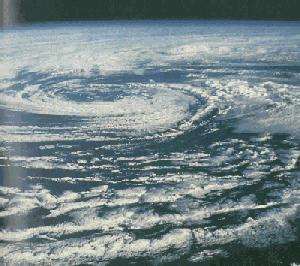

The
earth atmosphere and a hurricane over the The Mountains become bluer and
bluer in the distance
Caribbean Sea
The satellite photographs show that the deep blue color of the oceans with the white color of the clouds scattered everywhere dominate the bluish brown and green color of the continents that can barely be noted, but by carefully looking we can notice at the earth circle rim a very thin light blue layer, in contrast to the black space background. That is the atmosphere.
It is indeed a very thin layer since 90% of its mass is inside the first 58,000 feet of altitude, which is just a small fraction of the 7,500 miles earth diameter, and it is composed of basically 78% of Nitrogen, 20% of Oxygen 20%, and the remaining 2% of other gases, from which only the water vapor deserves to be mentioned, in special at warm and humid regions.
Is the air really thin and light? Lets see: This may be true when the air is at rest, but at 60 mph it will already apply a force of 9,2 lb.* for each square feet of surface that we place trying to stop it. At 120 mph this force will be 37 lb*, and it will be multiplied by four each time the speed is doubled! (Note: The reader who is unfamiliar with the physical systems of units, consider lb* as a pound and that is it).
If we approach the speed of 760 mph this "thin" air becomes very "thick" creating the so called "sound barrier", a much feared phenomena for the pilots who for the first time tried to reach this speed, in the forties. To better understand how this happens we need to have a good knowledge of this companion of our flights, enough knowledge to get into its "soul"!
Lets take a small cube of air having only one mm of side and amplify it 10,000,000 times! "Wow! " ten million times is quite a lot, isn't? Yes, it is indeed, but we can then consider each millimeter to be an Angstrom. What's that? An Angstrom is such a minimum distance that in a millimeter we can have ten millions of it.
By doing that, the first thing that we will note in our enlarged cube is...just empty space! Yes sir, mostly empty space, but then at each 30 Angstrom we will notice molecules or pairs of tiny spheres measuring around 4 Angstrom each, in the case of those formed by the Nitrogen atoms.
An impressive idea of how small the air molecules are is given by the fact that there are more air molecules inside our lungs than there are gallons of air in the entire atmosphere! This allows us to state that inside the lungs of the reader, we can be sure to find one nitrogen molecule that has also already been breathed by the Tutakamon pharaoh, in his short live in the ancient Egypt! This assurance is based in the application, for the elapsed time, of the statistics principles, and of the gas diffusion laws.
Coming back to our amplified cube we will verify that all these molecules are not at rest, but that they move at random in all directions colliding among one another, a collision occurring in mean at each 600 Angstrom of travel. Some of them are nearly at rest while others travel at 1,800 mph, and the mean traveling speed of them all, found with a quadratic mean computation using only the speed values is around 1,100 mph.
If in order to compute this mean, we take into consideration not only the speed values modules, but also the direction and the sense of these speeds (a vectorial mean computation), then the mean speed found can be for instance: zero for the air molecules inside a closed room, and 10 knots in the south direction for the outside air molecules when moving in a light North breeze. Finally if we take into account only the projection of these speeds in one single direction and in a single sense of this direction the speed mean result will be 760 mph!
But isn't that the sound speed? For sure it is and that is not by chance. Any disturbance in the air can only be propagated by means of air molecules collisions and a sound is nothing else than a repeated disturbance done somewhere else and transported through the air to our ears by the sound waves.
We can not see the way the sound waves
propagate in the air, but it is very similar to the way the water waves
propagate over water surfaces as can be clearly seen, for instance, by
throwing a stone on a calm lake.
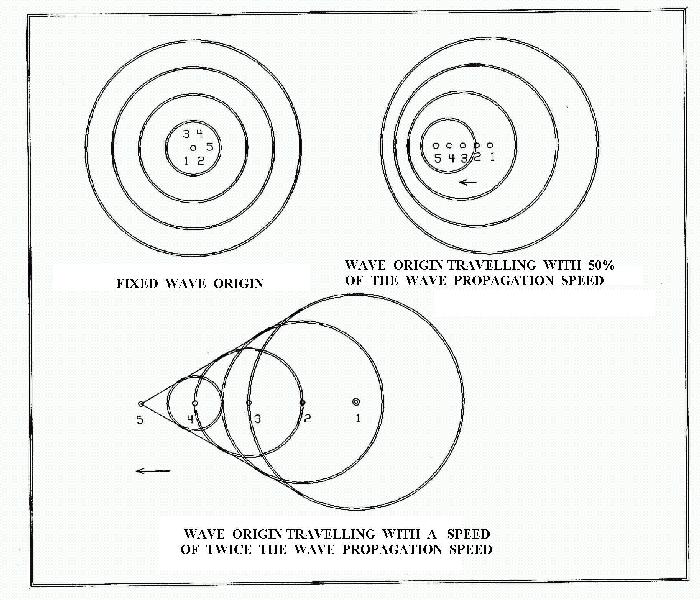
How
the chock "Mach" cones is formed.
The same way a boat leaves behind it a "V" formed by a strong surface wave and disturbed waters, any object traveling in the air at a speed higher than the speed of the sound, leaves behind it a "V" of a strong sound wave, which is called a sonic chock. Like the "V" waves of a boat are stronger, the higher are its weight and its speed and the nearer it passes by, also stronger are the sonic "bangs" of a supersonic flying airplane, the heavier it is and the faster and lower it flies by, so that they can even shatter windows.
![]() - Floating in the air.
- Floating in the air.
All the speed values given till here are for the air at a 15 Celsius Deg of temperature and at the sea level, where pressed by its own weight the air is most dense. If we climb, the air becomes less dense with the altitude; that is, we have less air molecules for the same air volumes.
Above 14,000 feet of altitude the number of molecules falls so that the Oxygen molecules, although keeping its same sea level 20% proportion, are not enough to permit the proper functioning of our lungs, and in order to increase their number it is wise to use Oxygen masks or pressurize the cabin. Above 50,000 feet of altitude the number of air molecules is so low that the cabin pressurization becomes a mandatory issue otherwise our body fluids start to boil in order that their molecules could fill the empty left space.
When we reach the altitudes where the artificial satellites orbit we still find air molecule, but so few that for instance at an altitude of 1,300,000 feet they will collide one against each other only after a 6 miles travel! "Poor them"! What a difference to a meeting at every few Angstroms! Although being rare, these molecules are enough to, with the help of the "solar wind" atomic particles, can bring slowly down to the earth any "low" orbit satellite, by their collisions against its surfaces.
Since the early times the man has observed the forces that the moving air can generate, and even without well understanding them, he has managed to put them at his service by building windmills, sailboats, etc. In the XVIII century the air was first used to lift balloons, by applying the knowledge already developed in the XVI century, by the Italian Torricelli.
Nature, however long before started the use of the air as a means of transportation for the vegetal seeds and for the animal locomotion, first by the primitive flying insects and latter by the flying reptiles, these around 200 million years ago!
By observing the nature and the birds, the man decided that he would also fly, and today we can really do it, and by the most different and strange manners using; balloons, delta wings, trikes, gliders, airplanes and rockets. Today we have also elaborated the aerostatics and aerodynamic sciences, and we are now going to deal with some basic concepts of them, all in a simplified manner and also using some of the gas theory or "intimate" knowledge we have got about our ally (not always!), the air.
A first basic fact is that all forces exerted by the air on any body immersed on it come exclusively from the shock of the air molecules against the external or internal surfaces of this body, no matter which one is moving or is at rest, either the body or the air. Also, no matter how we call them: Lift, Push, Drag, etc. they result of the vectorial sum over these surfaces, and in a specified direction, of only two components: a perpendicular to surface component that we call pressure and a parallel to surface component that we call friction.
Press your hands one against the other and you will feel what pressure is, and rub your hands one against the other and you will feel what friction is. Isn't that simple? Yeah ! Anything else, it is like giving different names to different pets that otherwise are from only two distinct species, either dogs or cats.
Ah...And what about that "induced drag force"? Hold on. Soon we will talk about that. For now, let us begin with the surface forces exerted on a body at rest by the also "still air", although as said before, the air molecules are never at rest.
We normally do not feel the air pressure because the air molecules are bombing us equally from all the sides and directions but we can easily manage to change that: Cover your mouth with the palm of your hand and inhale some air from inside of your mouth to inside your of lungs. You will then have more air molecules colliding against your hand coming from the outside than from the inside of and you will so feel a force pressing your hand from the outside (or sucking it from the inside?).
If we were able (our thorax muscles aren't) to inhale all molecules of the mouth, this force would be, at sea level and 15 Celsius degrees, about 14 pounds for each squared inch, exerting a pressure that we call a "bar" or one atmosphere.
As we have already seen, the number of air molecules falls with the altitude and therefore the same occurs with the atmospheric pressure even for the slightest altitude variation. Thus the air pressure over any body will always be greater on its lower surface than on its upper surface and so, there will always be a small force, proportional to the body volume, pushing it up slightly.
Why then, Very light bodies, such for example a child air balloon, why does it not go up when it's released? Simply because this up pushing force is exactly equal to the weight of the air molecules that are inside the balloon volume and due to the rubber skin additional weight, it goes down.
If we changed the nitrogen and oxygen air molecules inside of the balloon for the lighter hydrogen or helium molecules, the weight of the internal gas plus the weight of the balloon skin would be smaller than the atmospheric push, and the balloon would then go up, and very fast for a great desperation of any boy that will not be able to hold the string.
By heating the air, the input energy increases the speed of the air molecules resulting is stronger shocks between them, which keep them further apart one from another and so the air becomes less dense or "lighter", having less molecules for the same volume. That is what happens inside our hot air balloons that go up like the child balloons, but which climb can now be controlled by a heat input control.
![]() - The air in movement.
- The air in movement.
Let's now take a closer look on the surface forces created by the air flowing around a body at rest, and on those appearing on a body when it is moving in the air. For both cases these forces are exactly the same if the airflow or the body speeds is the same and does not change with time!
The aerodynamic books and the scientists, almost always consider moving fluids and motionless bodies since this is the case inside the wind tunnels used to measure the air forces and verify the aerodynamic theories. For us however, it will be perhaps easier to use the opposite approach because we fly moving in almost still air, since the wind and turbulence speeds are generally much lower than our flight speeds.
And the first thing we shall do, is to forget the real air with all its molecules, and instead to consider a theoretical air formed by "very small particles", just but big enough to contain million of air molecules.
By doing so we will be able to discard the individual molecule speeds, and to consider only the "vectorial" average speed (in value, direction and sense) into each particle and that we will simply call: air speed. This is not difficult because the nervous cells of our skin have also such a size that they can only feel the average impact of the "real" air molecules, so that what we really feel is the impact of the particles, which are "unreal"! Oops!
Let's ever not forget this, since I have seen some aerodynamic textbooks dealing with the air particles, mathematical entities as being physical ones! Not worse than others that state that the induced drag is the result of the energy spent by the wing tip vortices, or than the airplane flight explanations given by some encyclopedias!
Using the particle simplifying assumption we can now state the basic principle of aerodynamics that is: "To any air particle speed change provoked by a moving body, there is always a corresponding force on this body acting in the opposed sense to this speed change." And its reverse is also true: "To any aerodynamic force acting in a moving body there is always a corresponding mean speed change of opposed sense in air particles"
Does it seem complicated? It may be, but that is simply the aerodynamic translation of the well-known action and reaction basic principle of physics, which as we will see, can greatly clarify the flight phenomena.
It is also important to know that the same aerodynamic force result either from a small volume of air being dislocated at high speed, or from a larger air volume dislocated at lower speed. But despite the forces being the same, smaller volumes and greater speeds mean greater needed power to produce them. Just as we can feel in our lungs and heart beat, when pushing a dead battery car to its garage, the demanded power to apply a force is proportional to the speed of its application.
"Aerodynamics is very simple, but be careful"..., used to warn us "Herr Schrenk", our German master in the gone 58 at I.T.A. University, ..."because FFFFFF"..., (saying with the air spilling out of his mouth),..."is quite different of HSHSHS" (with the air being absorbed). Really, when pushing the air out we create a cylindrical spurt, with which we can extinguish a lighted match placed 20 inches away. When inhaling the air, even making a tube with the lips, the air penetrates coming from all around, and its movement can only be felt at a very short distance, so short that it is better to replace the lighted match for a finger tip...
![]() - Facing the wind.
- Facing the wind.
Let us place an open hand out of a car traveling at 60 mph (check the rear mirror first) and the effort to keep it in this position will be like holding a one pound bag. We could imagine that the average impact speed of the air molecules would have increased from 760 mph to 830 mph in its front surface and reduced to 760 mph in its rear surface and that this would explain the resultant pressure difference and force. Right? Absolutely!
The average impact speed of the molecules on both sides of the hand surfaces will be the same (~1,100 mph), but the effects of their shock against the hand will be propagated in all directions at 760 mph modifying the molecule and the air particle speeds even before they are reached by the hand.
In the front face of the hand this happens in a noticeable manner only at small distances, like in the inhaled air example we have seen, but as result, the molecules accumulate there, in special at its center, increasing the number of shocks and so the pressure. At 60 mph this accumulation is of only 5%, but it is sufficient to produce a pressure of 9 pounds per square feet.
The air particles will escape from the hand center to and around its edges, and those that have acquired the same speed of the hand will be "dragged" behind it, keeping the number of molecules and pressure unchanged at the hand rear face (see figure). In the border between the dragged and non dragged particles, eddies (or vortices) are formed as consequence of the particle abrupt speed change or "shear".
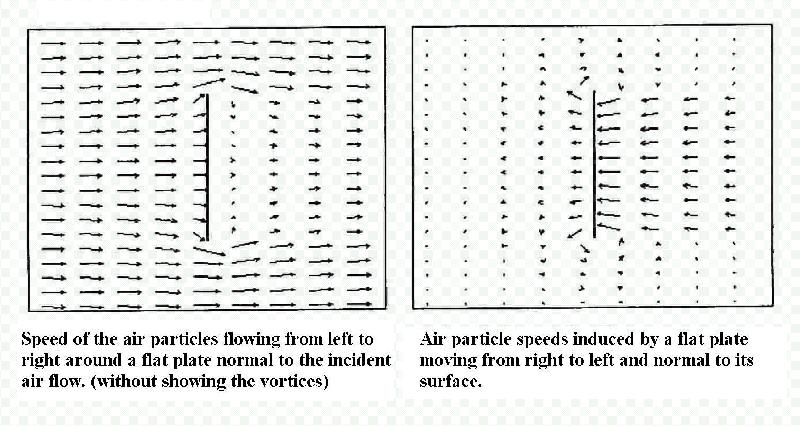
That force that we feel in the hand placed out of the car or in the row is called pressure drag. It comes exclusively from the increase of pressure in their front face, and to confirm the law of the action and reaction its sense is opposed to the speed variation of the dragged air particles or water.
The row, the water wheel, the "spinnacle" sail, the insect wing, etc. are mechanisms in which this drag force is used as mean of propulsion. For that however, the use of another type of aerodynamic force that will be explained ahead, the "lift", is much more efficient, and so in most vehicle design, what is sought is the maximum reduction of the pressure drag. The roadside vegetation movement that follows the passage of a buss or a trunk type truck gives an idea of the wastefulness of energy and fuel caused by the pressure drag.
For cars, the use of wedge fronts and cut backs can result in reasonable reductions in pressure drag, but only the use of elongated forms, such as those given to airships and airplane fuselages, could lead to negligible pressure drag values. With these shapes, it is possible to obtain a pressure increase also at the back part of a body, thus compensating the drag force of its front, which can be smaller for pointed shapes, but is unavoidable.
Another simple and efficient way of reducing a body pressure drag is to reduce its frontal or cross section area. For instance in the case of our hand out of the car, by turning it 90 degrees and putting it in a "cutting the wind" position, we can instantly feel a drastic reduction in its drag.
![]() - Sliding in the air
- Sliding in the air  Even
in a very thin flat plate perfectly aligned with the wind, and therefore
having practically no pressure drag, we can detect over their surfaces,
a fine layer of air particles being dragged in the direction of its movement
(see figure) and as a consequence there is a small force acting on it in
the opposed sense.
Even
in a very thin flat plate perfectly aligned with the wind, and therefore
having practically no pressure drag, we can detect over their surfaces,
a fine layer of air particles being dragged in the direction of its movement
(see figure) and as a consequence there is a small force acting on it in
the opposed sense.
This force is what we call friction drag and results from the parallel to the surface force components created by the air molecule shocks with the external surfaces of the plate. It will be larger, the larger is body surface in contact with the air, and the larger are the tangential speeds of the air particles near this surface.
If we observe the smoke of a cigarette, or the water flowing from a low pressure tap, we will observe on both cases that until a certain distance from its origin, the stream is continuous and smooth but from a certain point on, oscillations and small eddies appear and the flow becomes turbulent. The air particles dragged by friction have a similar behavior and flows initially forming smooth layers or laminae and later, with the appearance of micro eddies, a turbulent stream.
In the laminar region, the friction that starts very strong, falls quickly because the also strong accumulation of the "dragged" particles reduce quickly the tangential speeds over the surface. As soon as the micro eddies appears, these slow speed dragged particles are moved away from the wall and are replaced by others having higher tangential speeds, so raising the friction and making it to fall much more slowly than in the laminar region. The net result is that in the laminar region the total friction is smaller than that in the turbulent one, and for that reason we seek to delay as much as possible, the appearance of the turbulence.
The larger are the particles speeds and distances traveled on the body surface compared to the molecular ones, that is, the flow "scale" quantified by that "magical" number you certainly must already have heard of: the "Reynolds Number", the earlier the micro eddies will tend to appear.
In the narrow wings of the gliders, that have special profiles and very smooth surface finishing, laminar flows can extend from the leading edge up to 50% of its upper surface, and up to 75% of its lower surface. In the airplanes wings of conventional construction the percentage of the surface covered with laminar flow at cruise flight altitudes and speeds, usually do not exceed 15% or 25%. In those made of composite material and having the so-called laminar airfoils, first used in the P-51 "Mustang" WWII fighter, up to 35% to 40 % of laminar flow can be attained. In the high speed and jet airplanes, the researchers try to extend the laminar flow beyond the 5% or 10%, but it proves to be a difficult task.
The laminar flow seems to be as unstable as a woman "in those days". Insects, rivet heads, sheet joints, undulations, etc., can anticipate the formation of the micro eddies, and therefore the leading edge surfaces of the wings, empennages, helices, etc. must be constructed and kept as clean and free of defects as possible. Really, for an optimized performance, the same care is applicable for all the remaining surfaces, since the drag provoked by each excrescency can be even greater in the turbulent flow region, where the particle speeds near the surface are larger!
All right, and the induced drag? We will see it later, because now we must answer to another frequent and not always well answered question.
![]() -
Taking off.
-
Taking off.
Why an airplane, being heavier than the air, can fly? Which pilot did not go thought such a test? The conventional answer normally starts with the description that the upper surface of the wing is more cambered than the lower one, and so the air in order to travel a larger distance over there needs to do it with a higher speed, and now, according to the Bernoulli's law, if the speed is higher the pressure shall be lower, etc...!
Such an answer besides being quite complicated It does not explain, how airplanes can fly upside down, neither how symmetrical airfoils like those used in the wings of the B-17 WWII bomber and in the "Sukhoy" acrobatic airplane can generate lift, nor even how can also do it, the flat surfaces of kites, scale models, etc.
Otherwise, by using the principle of action and reaction, which relates aerodynamic forces to air induced velocities, we can give a simple, correct, and the most intelligible reply that I know, that is: Driven by the engine, the propeller (or fan) blades due to their angle or "pitch", push the air backward, and by reaction this creates the thrust force that makes the airplane move forward. With the forward movement of the airplane, the wing, due to its camber and or angle of attack, push down a great amount of air and again by reaction this creates the lift force that pulls the airplane up.
The air stream pushed backward by a propeller or by a jet engine can be easily noticed by the pulled out hats or raised dust, since the involved air speeds are high. Starting around 60 mph for the small airplane propellers, they can reach 600 mph for the jet engines exhausts, going up to supersonic speeds in those that have post-combustion, as in the military airplanes and in the Concorde.
Otherwise, the perception of the "down-wash" airflow behind the wings is much more difficult because their vertical air speeds, being distributed through all the large area over flown by the wing, are quite small. For instance in the "slipstream" of a Boeing 737 at take-off, the mean value of the "down-wash" vertical speeds is a 20 Knots breeze (10 m/s), and in the takeoff of a small Piper airplane only 40% of that. A 50 feet wing of a 700 lb. glider, flying at 45 mph, produces a mere 0.7 m/s descending flow!
And for them all, the higher are the horizontal flight speeds, the smaller are the vertical speeds needed to obtain the same lift force, because the overflow area and so the deflected down air volume, increase directly with the speed.
Changes in the "down-wash" speeds along the wing create vorticies along its slipstream and any abrupt change creates a concentrated vortex. Since at wing tips the "down wash" speeds fall rapidly to zero, the wing slipstream is laterally bordered by two strong "wing tip vortices".
Whenever I travel in a commercial airplane to warm sea shore locations, I try to get a chair having a good sight of the wing trailing edge in order to, most of the times, be greeted at the landing with the vision of a rolling and descending "white smoke braid" going out from the external tip of the full deflected wing flap.
It is the low pressure that, inside the core of the vortices created by the vertical speed difference that exists between the flapped and un-flapped wing regions, makes visible by condensation, the otherwise invisible water vapor present in the typical hot and humid sea side air. Those who have never seen it should try to do so because it is a quite beautiful vision.
![]() - Lift, induced drag, and stall.
- Lift, induced drag, and stall.
Now that we roughly know why the airplane
flies, we can look for a better understanding of what happens in a wing
moving in the air. We can begin by coming back to our hand out of the car
window, initially lined up with the wind. Raising its front edge even by
a small angle, It will be already necessary to hold it firmly, since we
will feel a strong up wise acting force. Let us try to explain what goes
on (see figure).
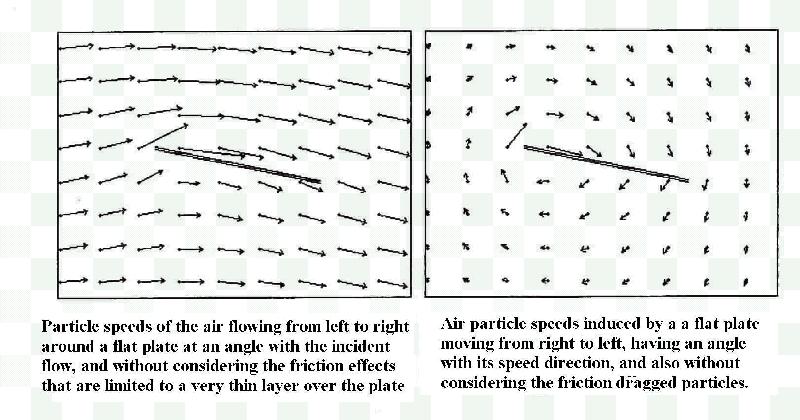
On its lower surface there is an accumulation of the molecules from the particles that are being deflected down as a swarm of tiny tennis balls shocking against an inclined tennis racket. This accumulation is greater on the plate leading edge, diminishes along it and vanishes in its trailing edge.
On its upper surface the particles are also down wise deviated as an effect of the molecular shocks with the plate and there is a reduction in the number molecules that is even larger than the increase on the lower surface, reduction that also falls along the plate and vanishes at its trailing edge. As result we have an increase of pressure on the lower surface and an even larger reduction of pressure on the upper surface.
Increasing the angle, the upper surface pressure reduction can reach more than twice the value of lower surface pressure increase! The resultant force on the plate also increases, and obviously the same happens with its "backwards" or drag component, which will be larger, the larger the angle is. Hey there folks! It seems that the induced drag has made its "debut"!
This pressure drag component, added to the always present friction drag, which has also been increased by the higher tangential speeds on the upper surface, increase the number of dragged particles that accumulates in the rear or "trailing" edge upper surface of the plate.
When the plate reaches an angle value, that depending of the plate plan view and cross section geometries, could be somewhere between 10 to 20 degrees, the dragged particles, affecting initially only the plate trailing edge start to invade its entire upper surface.
When the "invasion" is complete the number of molecules on the upper surface comes back to normal and the suction on it vanishes. The normal force component on the plate then becomes only the result of the pressure increase on the lower surface and so is greatly reduced. For flat and thin plates all that can happen for small angles and in a very sudden manner.
This is the "stall" a phenomenon that
all pilots know and have already experienced to occur with the wings in
their aircraft and that if occurring at low height can be fatal.
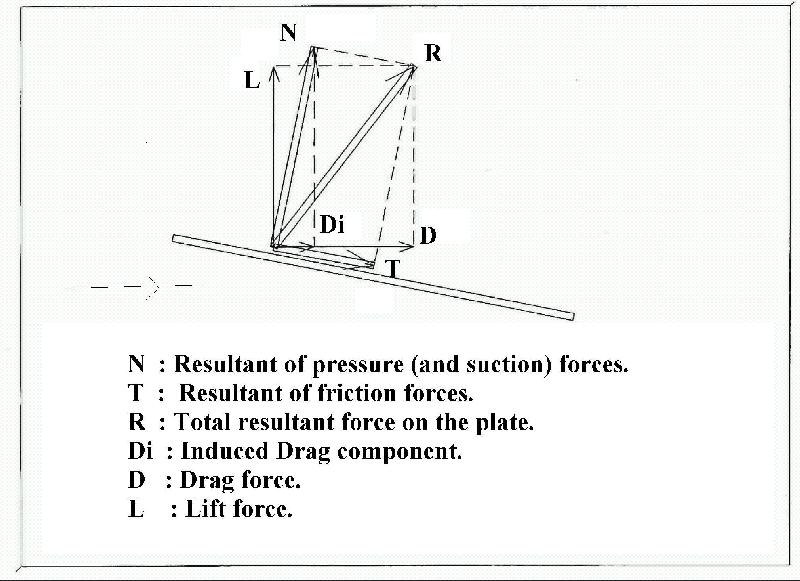
The airplane designers seek, by playing with the wing plan forms, profiles and aerodynamic "gadgets", to obtain an invasion of dragged particles as slow and gradual as possible, and progressing from wing root towards its tip. All that in order to obtain the maximum possible lift force and that the pilot could have time to feel the "stall" being able to reduce the angle of the wing before it is fully developed, all that without loosing its airplane roll control. A complex target indeed!
For that, the lower surface of the wing trailing edge can be deflected forming a "split flap", to attract and concentrate the dragged particles over it. The dragged particles can also be swiped away by the use air jets flowing through slots in the nose of "slotted" type flaps and or also in the wing leading edge, all in order to protect their strong suction peaks. For this purpose, even vortices can be used, as in the supersonic fighter's delta or cranked wings or in the Concorde slender delta wing that can reach an angle of attack close to the 30 degrees without stalling, but obviously at the cost of enormous values of...induced drag!
I suppose that it is now quite clear
that the induced drag is nothing else than simply the opposed to flight
path (usually backward) component of the force resulting from wing surface
pressures, from which also results nearly all the wing lift, or the normal
to flight path component (usually upward). Being so, the larger the lift,
the larger are the angle necessary to get it, the drag and the down-wash
speeds and also stronger are the wing tip vortices, which do not create
the induced drag, but just have the same origin.
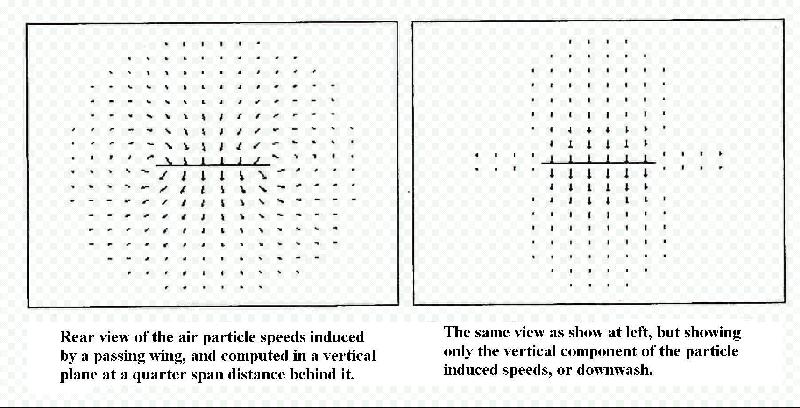
To better understand now, the relation between induced drag and wing span, it is important to know that the particles deflected down by a wing, are located inside of a cylinder, whose diameter is defined by the wing tips (see figure), and which circular cross section area is then proportional to the square of the span.
Let us then compare for instance two airplanes that have the same weight and the same wing area, both flying at the same speed, but that one has a wing span which is twice the wing span of the other, a much slender wing.
By deflecting an "air tube" with four times smaller cross section and so containing four times less air molecules, the short span wing needs four times larger vertical or "down-wash" air speeds to create the same lift. Since the horizontal flight speeds are the same, this implies in an (induced) angle of attack and in a induced (pressure) drag that are about four times larger than those of the double span wing which has a four times greater "aspect ratio".
In non planar wings like biplanes, wings with winglets, etc. the particles inside an additional rectangular area having the length of the wing span and the height of the biplane gap, winglet, etc. are also deflected and so at the same speed their induced drag are always smaller than that of a monoplane having the same span and weight.
And that is it!
![]() - A model of flight perfection.
- A model of flight perfection.
What about the wing camber? Well, since Leonardo da Vincci and Lilienthal, we have learned from the birds, that a much more elegant mode to deflect down the air, was to camber the surface of the wing, that being equivalent to give it an angle, paying a lesser drag price for lift. As nothing comes for free, we need to pay it with additional structure weight due to the greater aerodynamic twist moment acting in a cambered wing, and also due to the larger balance loads in the horizontal tail that are needed to counteract it.
As those negative effects increase with the speed (squared), the ideal is to have variable camber wings, as the birds do, with small camber at high speeds and large camber at low speeds, when great deflections to the air are necessary. For that reason the camber of the usual wing airfoils (or of their "mean" line) is normally limited from 3% to 5% of the wing width (or "chord") and to achieve the higher curvatures needed at low speeds we use the deflection of flaps and slats, that may also increase the wing area.
The birds however, besides having wings with variable camber and area can also change their wing dihedral, twist and sweep angles in order to adjust the lateral orientation of the wing lift force and its relative position to their center of gravity. Really, if we can surpass the birds with our flying machines in speed, size and carried load, we are still crawling behind them in many other aspects.
Those in doubt should compare the structural efficiency of bird skeletons made of nearly hollow bones, against that of the most modern airplane, employing resin and carbon or Kevlar composite materials. Compare also the propulsive efficiency of flapping wings, which gets all together thrust and lift, against those of propellers or jet engines. And at last, compare the flight maneuverability and control resulting from the already mentioned "full" variable geometry of bird's wing and tail, against the limited command of our airplanes, piloted by only three main control surfaces!
Indeed in all these aspects the comparison show the birds to be the winners. Nothing to say of many other birds aerodynamic devices as the specialized "alulas", "remigea" and other feathers that are used as active and retractable controls in slots, multiple "winglets", etc., or as passive controls such as in the wing acoustic treatment of the night predators like the owl, etc.
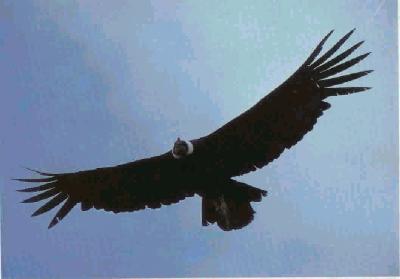 An Andean Condor and its "winglets"
An Andean Condor and its "winglets"
Has anyone heard of a bird that died in consequence of loss of control and "stall" in a low speed approach?
No doubt that in some aspects, our aeronautical engineering techniques are still crawling, but that is no shame if we compare our limited 80 years of experience, against the millions of years of attempt and error taken by nature evolution to arrive to the birds. Like in the Mateus VI, 26 evangelic text, we should say: "Look at the birds in the sky, they do not compute nor design, and even with the most sophisticated machines, we do not fly as they do!..."